�
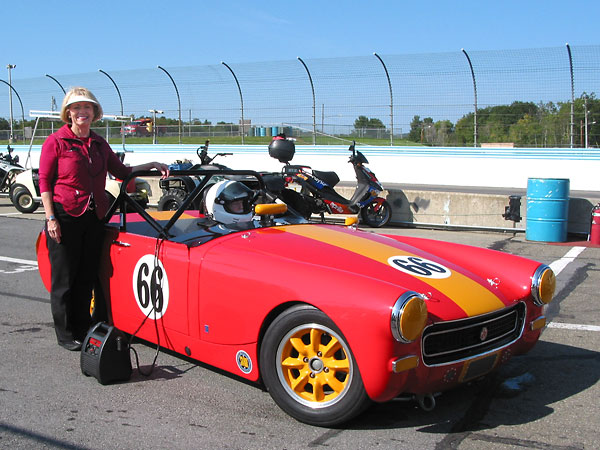
�
John McCue's 1972 MG Midget, Number 66
� � Owner: John McCue� City: Charleston, West Virginia
� Model: 1972 MG Midget
� Engine: 1275cc BMC A-series
� Built by: owner�
�
Features and Specifications
�| Engine: | �1275cc Spridget engine with 0.040" overbore. �
JE forged pistons. �
Carrillo connecting rods.�
Stock crankshaft, reworked by Moldex Crankshaft Co. �
Steel main caps with ARP hardware. �
Ported and polished cylinder head (1.4" intake valves and 1.14" exhaust valves.)�
14.2:1 static compression ratio. �
Huffaker Engineering camshaft and valve springs. �
Titanium retainers and bronze valve guides. �
ARP valvetrain hardware. �
APT lifters, with radius recut. �
Titan roller rockers (1.5:1 ratio.)�
Mallory Unilite distributor. �
MSD6AL capacitive discharge ignition system. �
MSD Blaster ignition coil and plug wires.�
S.U. carburetors rebuilt by Huffaker Engineering. �
K&N air filters.�
Winners Circle "Super" oil pan.�
Accusump oil accumulator. �
Remote oil filter. | �
| Cooling: | �Ron Davis dual-pass aluminum radiator. �
Modified aluminum water pump (with every other vane removed.) �
16-row aluminum oil cooler. | �
| Exhaust: | �Huffaker Engineering stainless steel through-the-tunnel exhaust system.�
(The header is a "long center branch" design, with specially selected diameters and lengths.)�
Megaphone (open) or Magnaflow muffler, depending on the noise requirements of the particular track.�
(Note: a Magnaflow stainless muffler was installed when we viewed the car at Watkins Glen.) | �
| Transmission: | �Taylor Race Engineering rib-case 4-speed dog-ring gearbox with �
1.83:1 first gear and 1:1 fourth gear. Quartermaster flywheel. �
Tilton 7.25" single disc clutch. Stock driveshaft. | �
| Rear Axle: | �Spridget axle housing. 4.22:1 gears mounted to a Tran-X limited slip differential�
(except when racing at Savannah, where 3.90:1 gears and a welded axle are used instead.) | �
| Front Susp.: | �550lb/in coil springs.�
Armstrong lever arm shocks modified by Apple Hydraulics.�
Steering arms modified to reduce bump steer. �
Winners Circle 7/8" anti-sway bar, mounted on aluminum pillow blocks and �
connected with 3/8" Heim joints. | �
| Rear Susp.: | �Gullwing (offset) semi-elliptic leaf springs. �
Armstrong lever arm shocks with Heim joints.�
5/8" anti-sway bar (which isn't used all the time!)�
Watts linkage for lateral axle location.�
A radius rod to the body eliminates axle rotation. �
(Note: dual anti-tramp bars were installed when we viewed the car.) | �
| Brakes: | �(master) Girling dual master cylinders with Tilton remotely adjustable bias bar. � (front) stock rotors and calipers. � (rear) stock drum brakes. | �
| Wheels/Tires: | �Panasport Racing 13x6 aluminum wheels with Toyo Proxes R888 185/60R13 tires. | �
| Electrical: | �Odyssey "Yellow Top" battery.�
TSI gear reduction starter. | �
| Instruments: | �AutoMeter Ultra Light gauges (left to right) �
tachometer (0-9000rpm), �
voltmeter (8-18V), �
fuel pressure gauge (0-15psi), �
coolant temperature gauge (100-280F), �
pyrometer gauge (1 of 2, 0-1600F),�
oil pressure gauge (0-100 psi),�
pyrometer gauge (2 of 2, 0-1600F), �
oil temperature gauge (100-280 F). | �
| Fuel System: | �ATL 8-gallon fuel cell.�
Facet fuel pump.�
Holley fuel pressure regulator. | �
| Safety Eqpmt: | �Simpson 5-point latch-and-link safety harness.�
Sweet Manufacturing splined, quick release hub (part# 801-70055), mounted on �
a Mountney "GT" steering wheel.�
Firebottle centralized fire suppression system. | �
| Weight: | �1435#. | �
| Completion: | �2005. Has raced about four times per year since 2005, with a podium finish �
in every race of the last two years. | �
| Racing Class: | �SVRA Group 1, F-Production | �
| Comments: | �John has built four Spridget race cars over the years. This one was a street car that had sat for �
several years waiting to be restored. A college kid decided that he didn't have the knowledge or �
desire to complete the project, but it was a really solid car. John sold all the extra parts in �
an amount equal to what he paid for the project.�
� Several changes are being made in preparation for the 2010 racing season, including: � (1) redoing rear suspension tie points so the rear sway bar will work with through-the-tunnel exhaust, � (2) rolling the fenders out about 1 inch, front and rear, to gain more tire clearance, � (3) rotating the driver's seat to a more upright postion for better feel, � (4) raising the rollbar to suit the new driving position, and � (5) switching to Hoosier T.D. bias ply tires. � | �
�
 �
�
�
�
Engine Installation
��
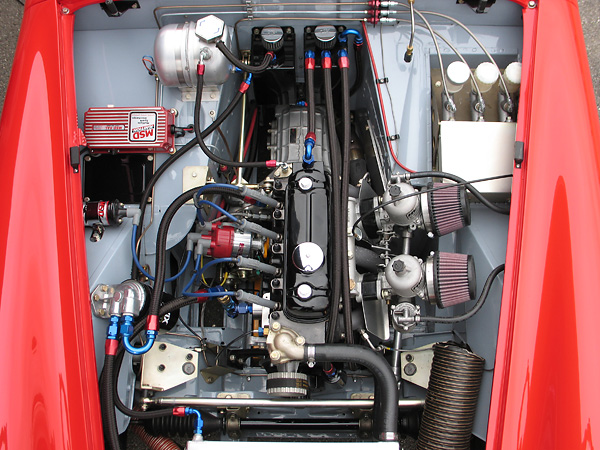
�
1275cc Spridget engine with 0.040 overbore, JE forged pistons and Carrillo rods.
�
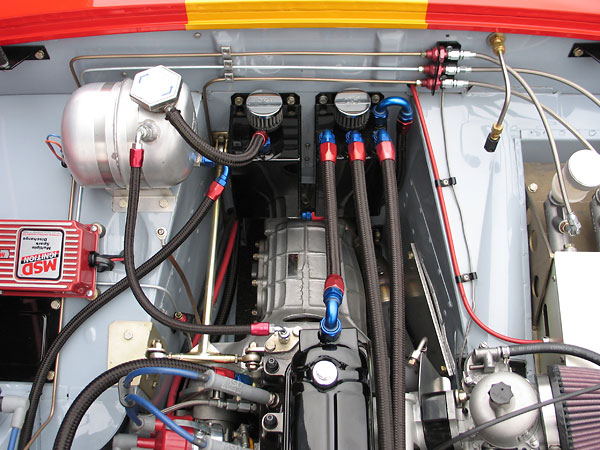
�
Unusual T-shaped engine steady bar.
�
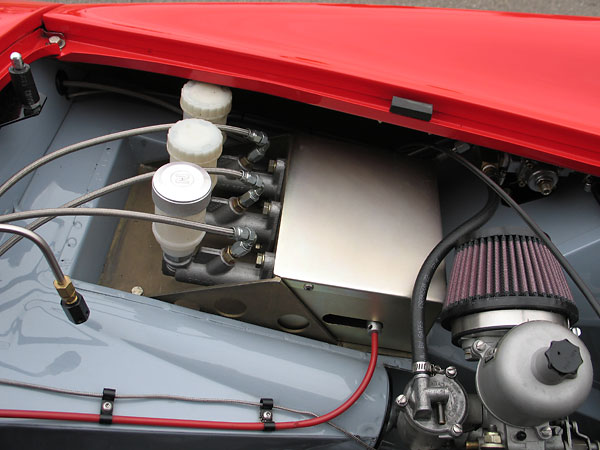
�
Girling dual brake master cylinders with Tilton remotely adjustable bias bar mechanism.
�
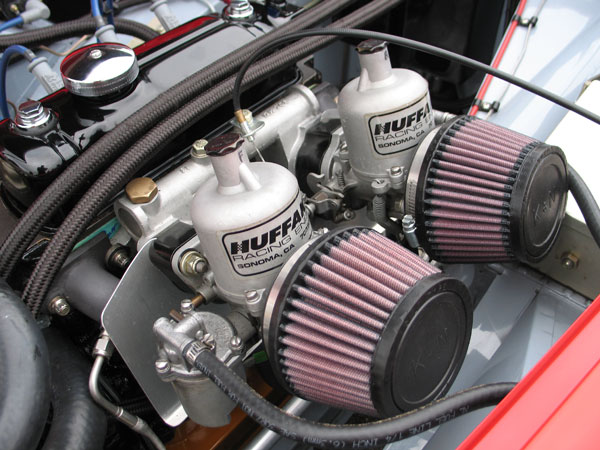
�
S.U. carburetors rebuilt by Huffaker Engineering. K&N air filters.
�
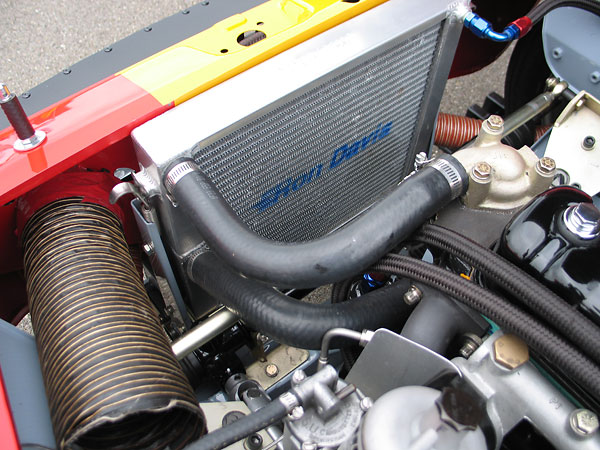
�
Ron Davis dual-pass aluminum radiator.
�
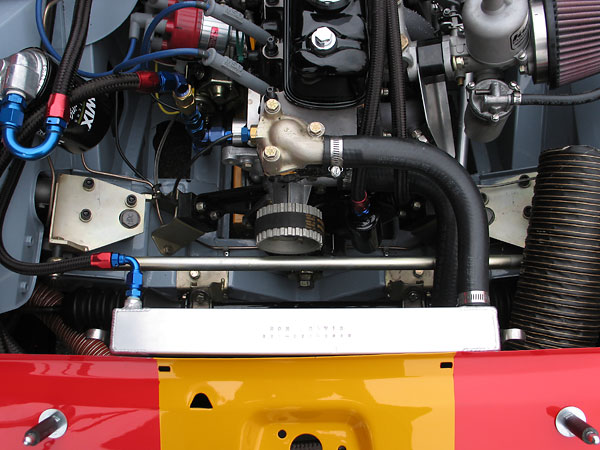
�
Two spring-loaded clips hold the radiator in place. It can be removed and replaced in minutes.
�
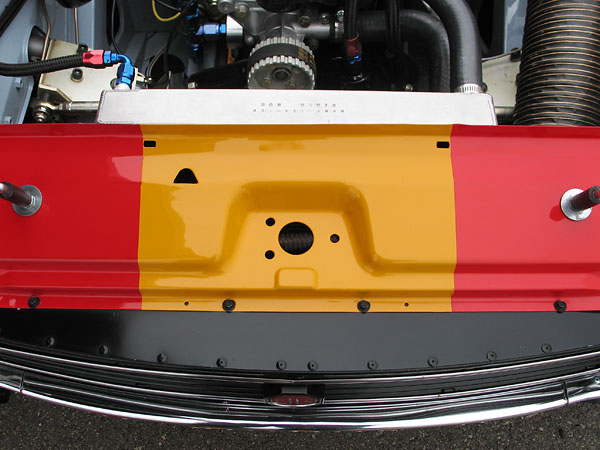
�
Airflow is prevented from bypassing the radiator core by this black, painted, aluminum shield.
�
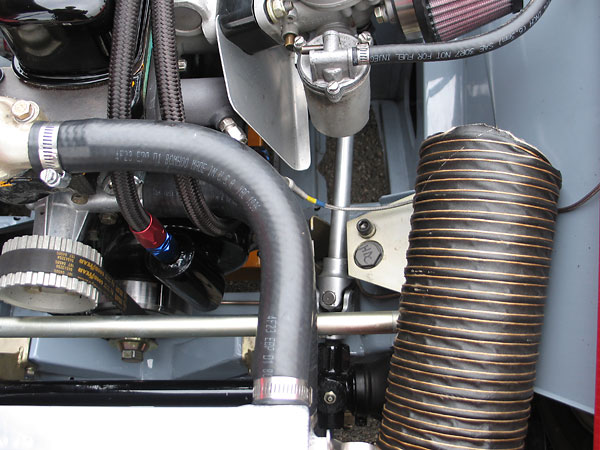
�
Every second water pump impeller vane has been removed to slow coolant flow and prevent cavitation.
�
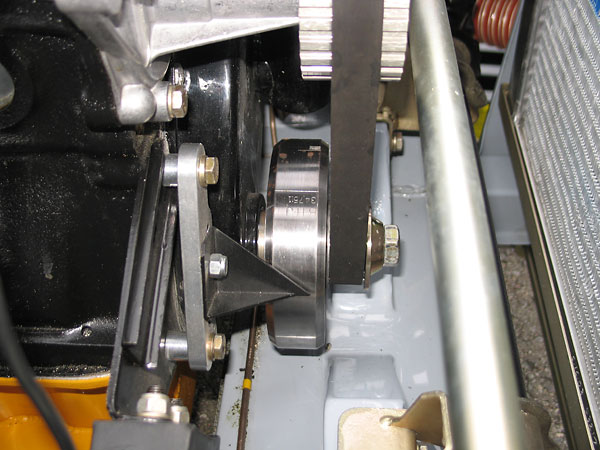
�
To provide improved access to the balancer, a V-shaped cut-out was made in the front crossmember.
�
(The new metal added back in is significantly thicker gauge than what was removed.)
�
The timing pointer is mounted to a bracket Huffaker Engineering makes for a crank-fired ignition sensor.
�
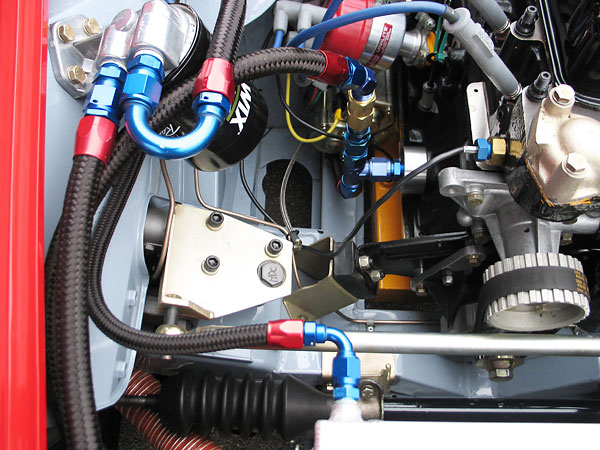
�
After V-notching the front crossmember, more strength was gained by fitting a Monte Carlo bar.
�
(That's what the pony car crowd calls a brace that spans from one front shock tower to the other.)
�
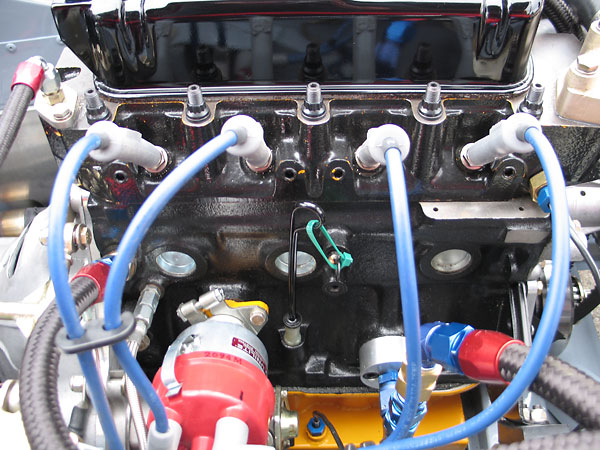
�
Notice the high capacity oil pan with side extensions. It has trap doors and a windage tray to
�
keep oil away from the spinning crankshaft, to prevent oil aeration and improve power.
�
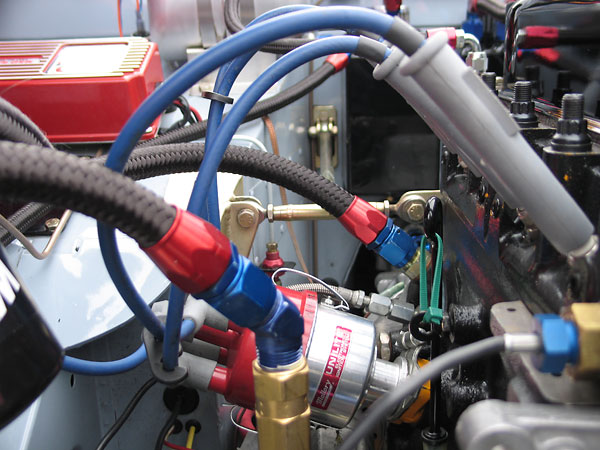
�
Mallory Unilite breakerless (optical sensor) distributor.
�
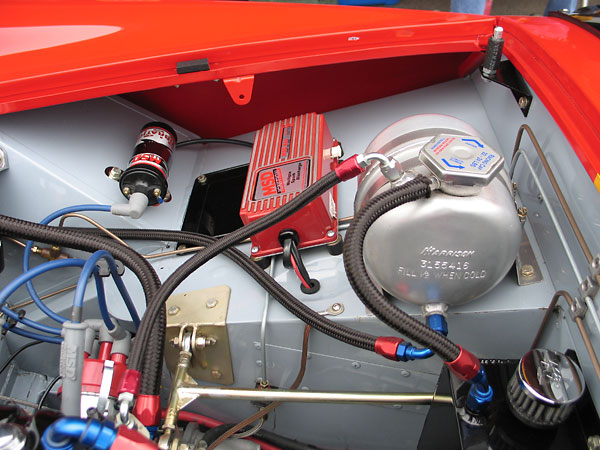
�
Harrison coolant header tank.
�
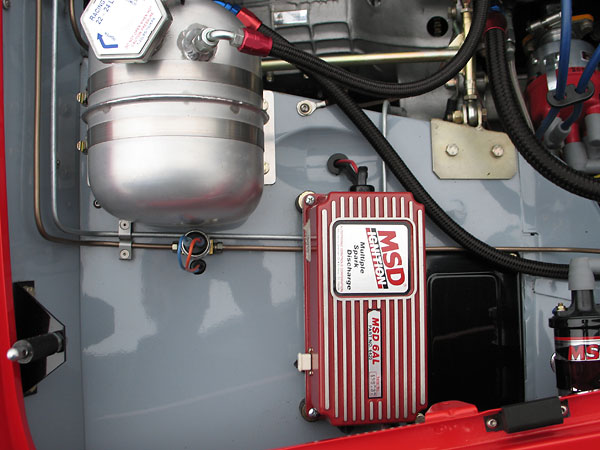
�
MSD: Multiple Spark Discharge ignition controller.
�
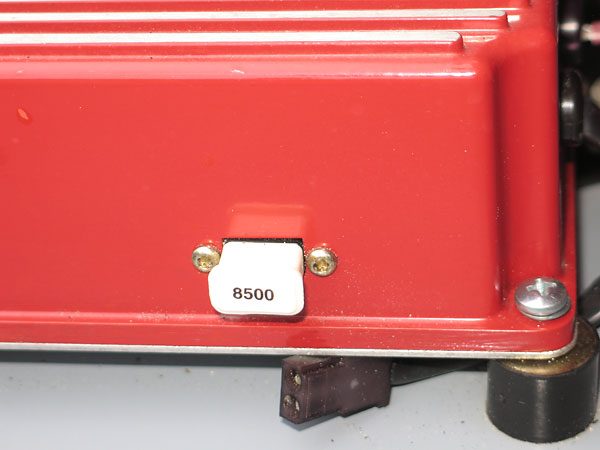
�
At Watkins Glen, the rev limiter feature of the MSD6AL ignition system was "chipped" at 8500rpm.
�
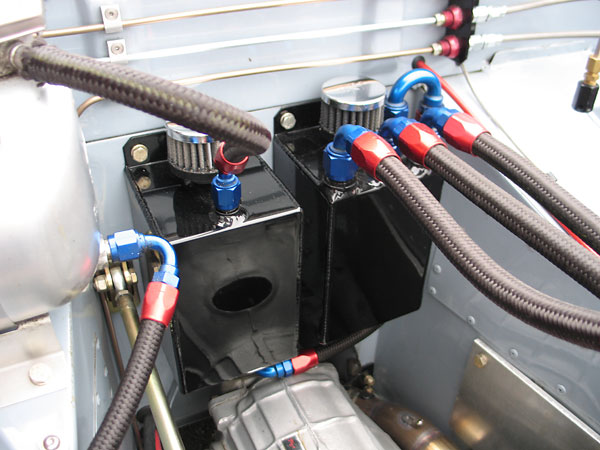
�
Coolant catch tank (left) and oil system breather tank (right).
�

�
Taylor Race Engineering rib-case 4-speed dog-ring gearbox with 1.83:1 first gear and 1:1 fourth gear.
�
Suspension
��
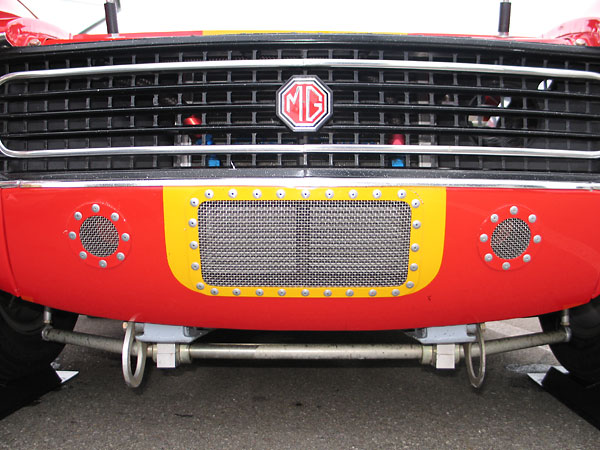
�
Oil cooler and brake cooling duct grilles in the front apron.
�
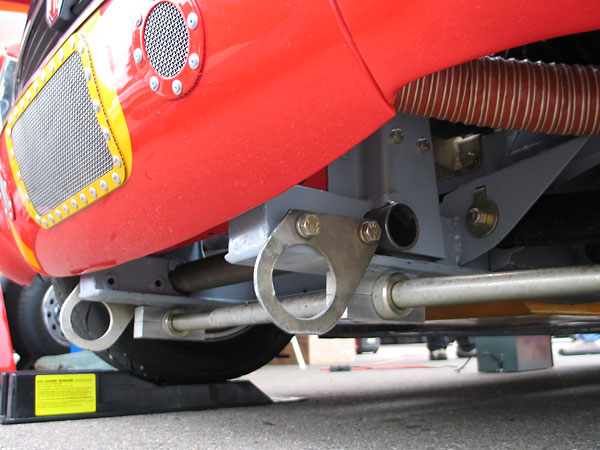
�
Tubular reinforcement of front structure.
�
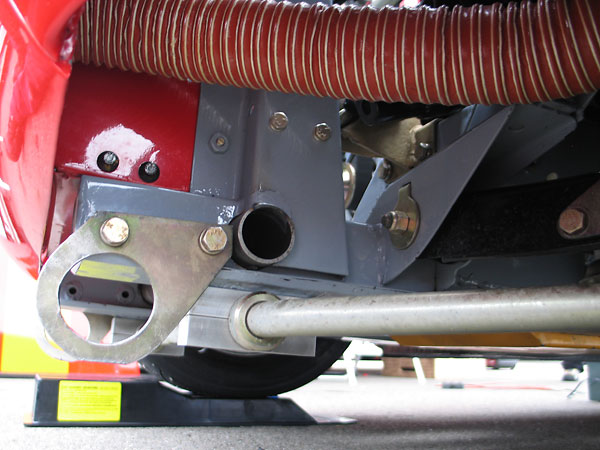
�
Tow eyes.
�
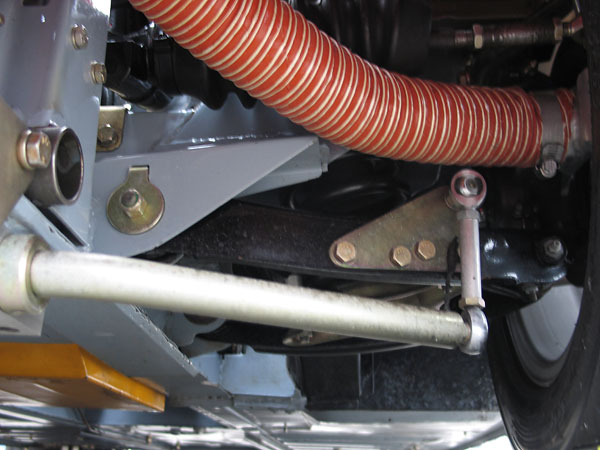
�
7/8" anti-sway bar with aluminum pillow blocks and 3/8" Heim joints.
�
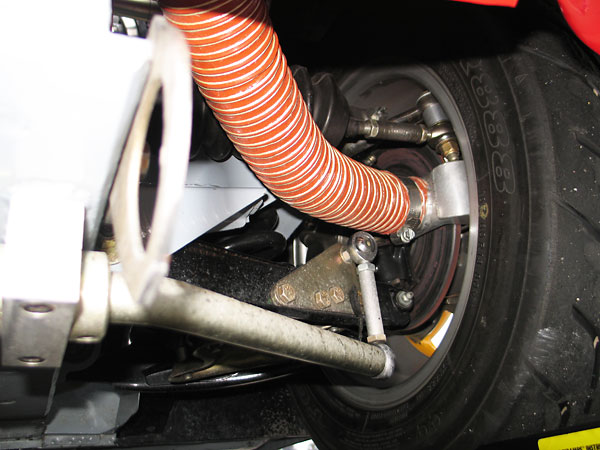
�
By class rules, the car is obliged to use stock front brake rotors and calipers.
�
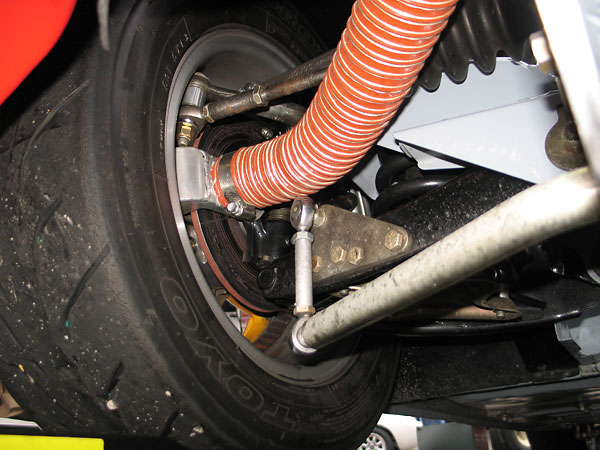
�
Brake cooling ducts help fend off brake fade.
�

�
ATL fuel cell. (Note: the tailpipe reveals that the engine has been tuned to run on the lean side.)
�
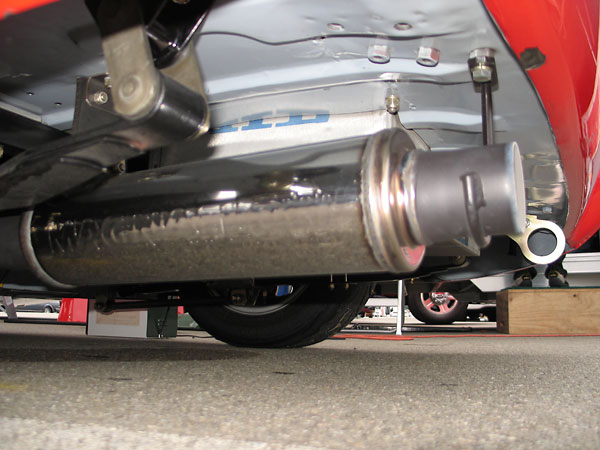
�
A Magnaflow stainless steel muffler was installed when we viewed the car at Watkins Glen,
�
but isn't required or used on tracks with more liberal sound rules.
�
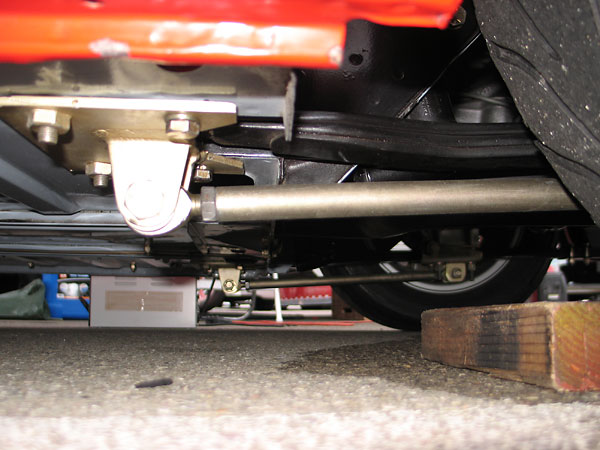
�
Anti-tramp bars were installed when we viewed the car, but they've subsequently been replaced
�
with a single radius rod to the differential housing.
�
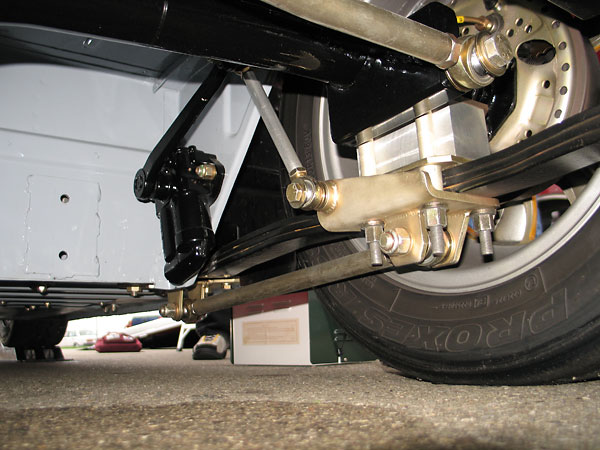
�
Aluminum lowering blocks.
�
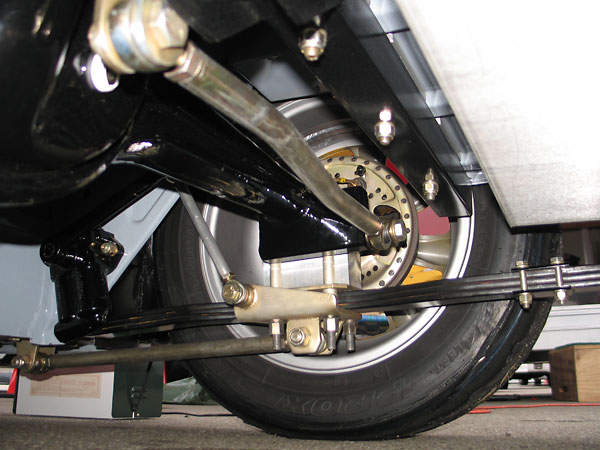
�
Watts linkage for lateral axle location.
�
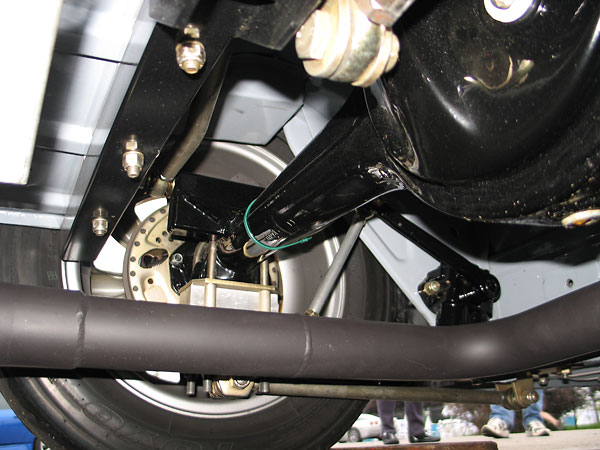
�
Armstrong lever arm shocks, installed with Heim jointed linkage.
�
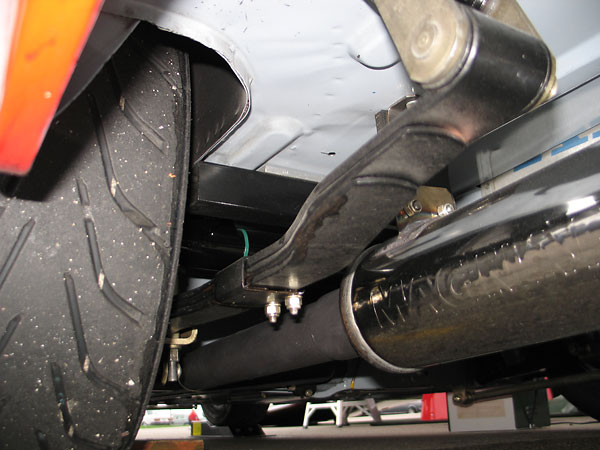
�
Gullwing (offset) leaf springs from The Winners Circle accommodate wide wheels and tires.
�
These springs are most popular for vintage racing, where class rules prohibit fender flares.
�
If the wide tires could be placed further outboard, straight leaf springs would be used.
�
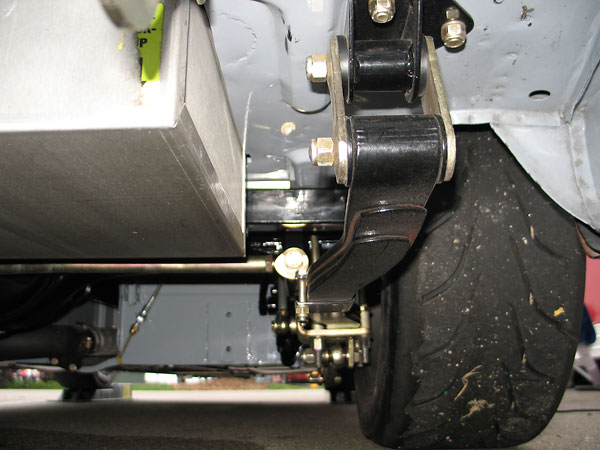
�
These springs have a significantly lower spring rate than stock leaf springs, so they provide less
�
resistance to "tramp" or "wrap". Some sort of radius rods are needed to supplement the springs.
�
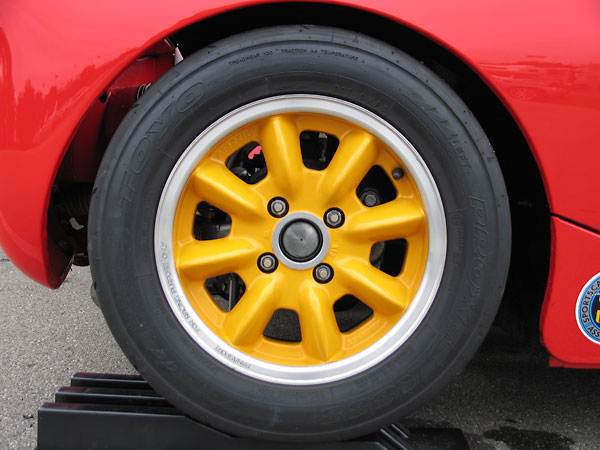
�
Panasport Racing 13x6 aluminum wheels.
�
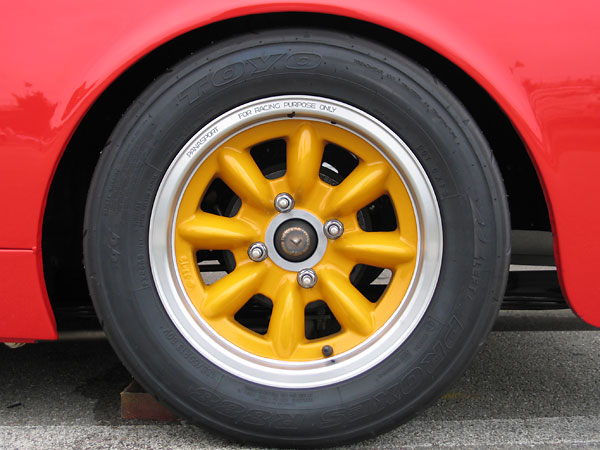
�
Toyo Proxes R888 185/60R13 tires. For 2010, John is switching to bias ply tires because they're more
�
forgiving. He believes the radials are faster, but they break away quickly and without warning.
�
�
Interior
��
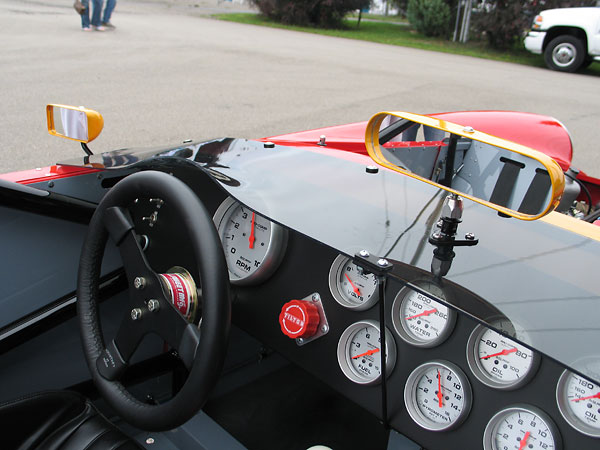
�
John molded his own low profile windscreen. Note also the Tilton remote brake bias adjustment knob.
�
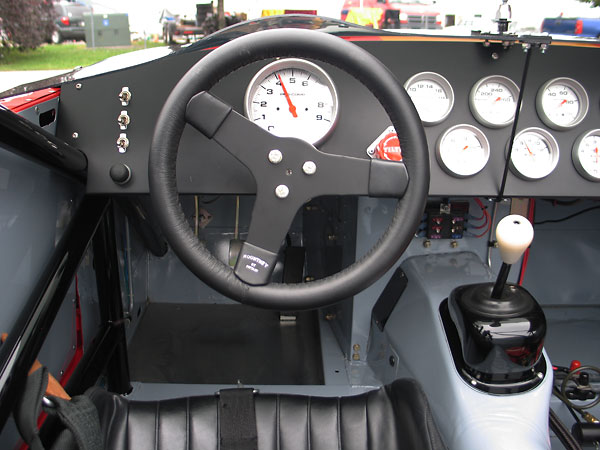
�
Mountney GT steering wheel, installed on a Sweet Manufacturing quick release hub (PN: 801-70055).
�
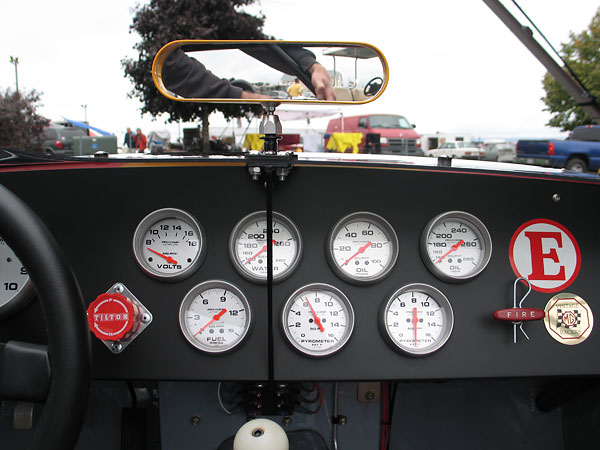
�
AutoMeter Ultra Light gauges (left to right), voltmeter (8-18V), fuel pressure gauge (0-15psi),
�
coolant temperature gauge (100-280F), pyrometer gauge #1 (0-1600F), oil pressure gauge (0-100 psi),
�
pyrometer gauge #2 (0-1600F), and oil temperature gauge (100-280 F).
�
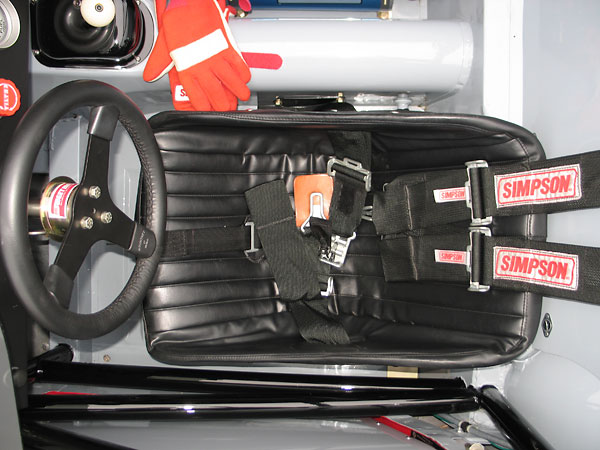
�
Simpson 5-point latch-and-link safety harness.
�
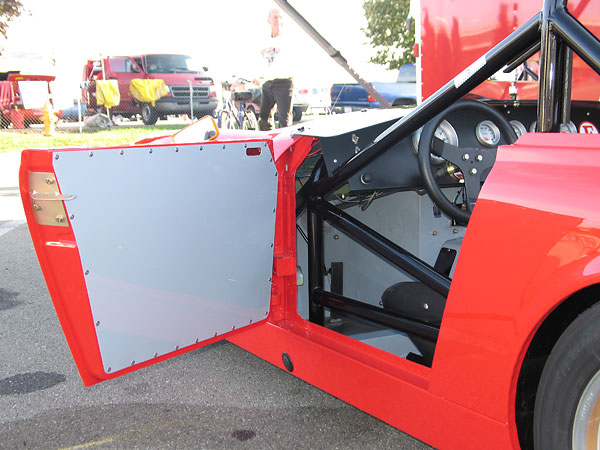
�
Aluminum door panel. Note also that the door latch has been replaced with simpler mechanism.
�
�
Enjoying this article? www.BritishRaceCar.com is partially funded through generous support from readers like you!
�
To contribute to our operating budget, please click here and follow the instructions.
�
(Suggested contribution is twenty bucks per year. Feel free to give more!)�
�
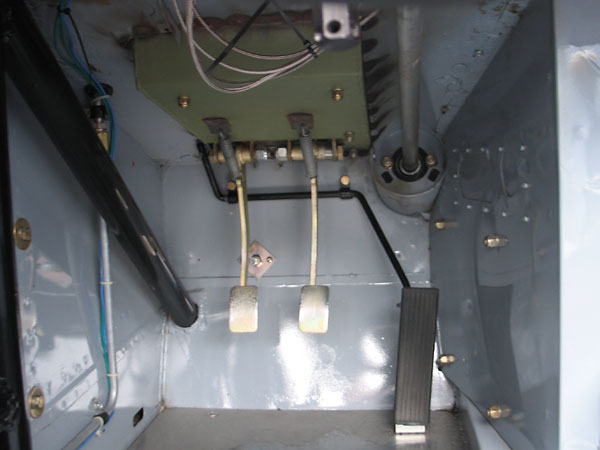
�
Footbox and pedals.
�
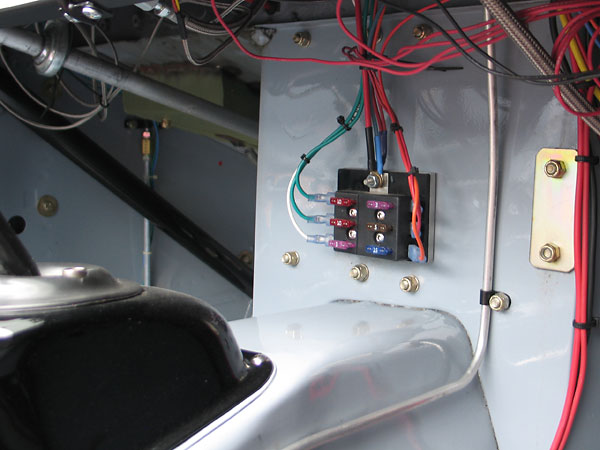
�
6-position fuse block.
�
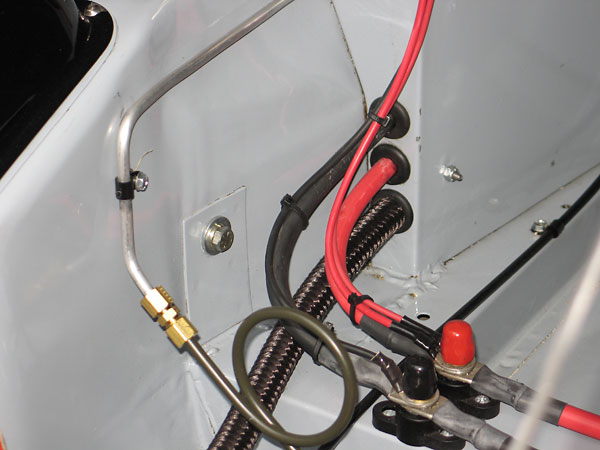
�
Power and ground studs.
�
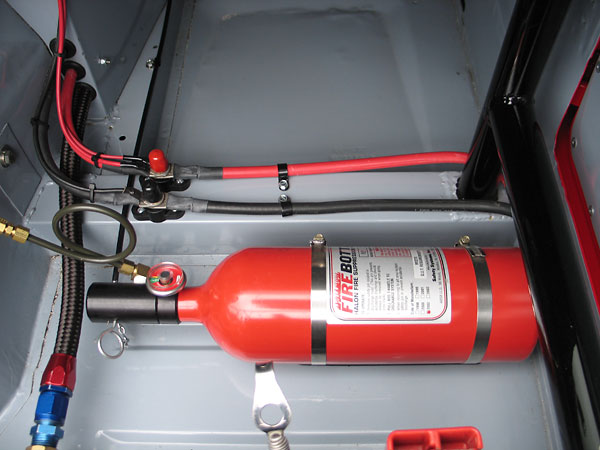
�
Firebottle centralized fire suppression system.
�
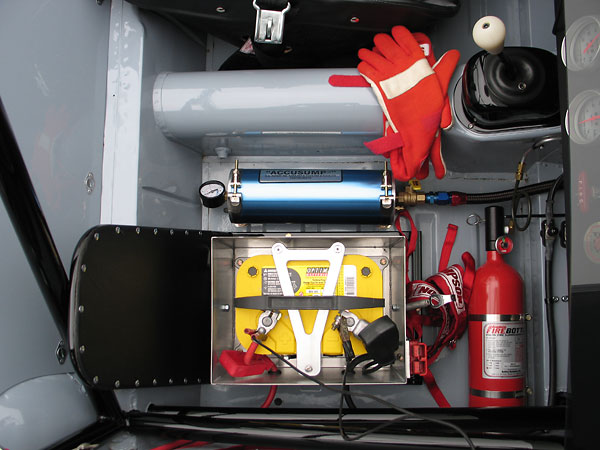
�
Since the Accusump oil accumulator is within reach, it's operated manually instead of via solenoid valve.
�
Optima "Yellow Top" battery. The battery box lid is padded because it's a "passenger seat", per class rules.
�
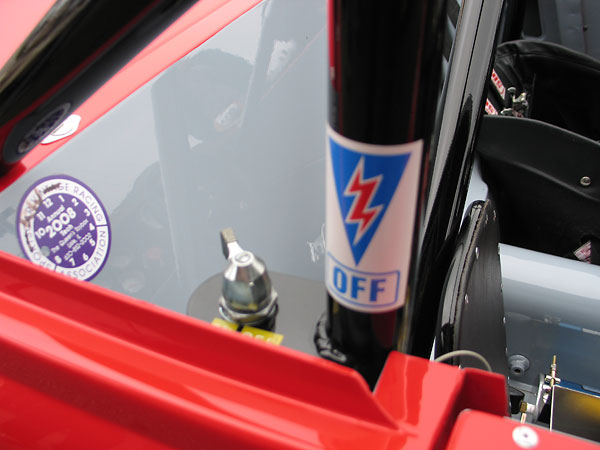
�
Engine "kill" switch. (Disconnecting the battery is sufficient since there's no alternator.)
�
�
Exterior
��
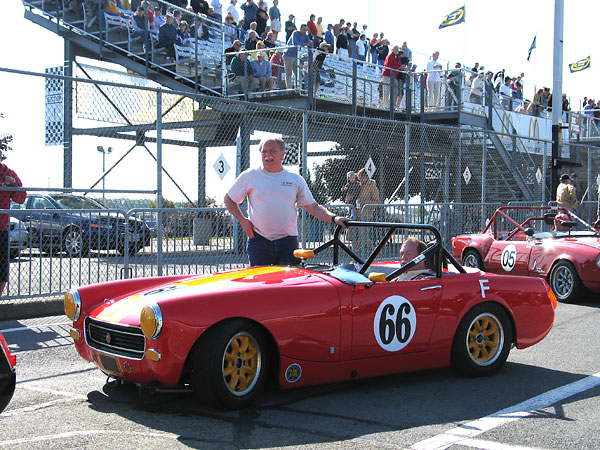
�
John McCue finished second overall in the Group 1 feature race of the 2009 U.S. Vintage Grand Prix
�
at Watkins Glen. His 2:22.972 lap time represents a very impressive average speed of 85.6mph
�
around the challenging 3.4 mile circuit.
�
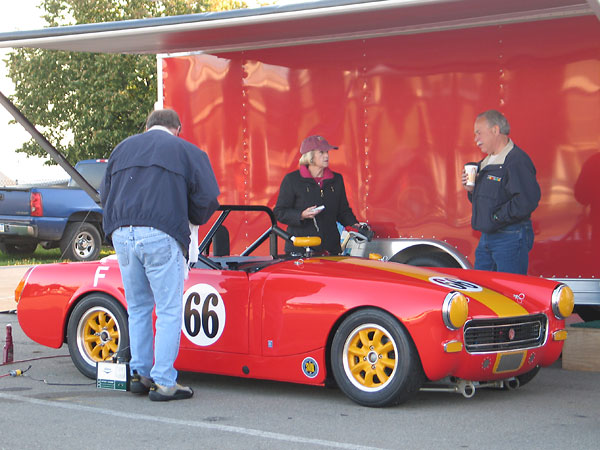
�
A great team: John's pit crew consists of Lydia McCue and Larry Born.
�
Back home, John's friend Laury Simpson does much of his machine work.
�
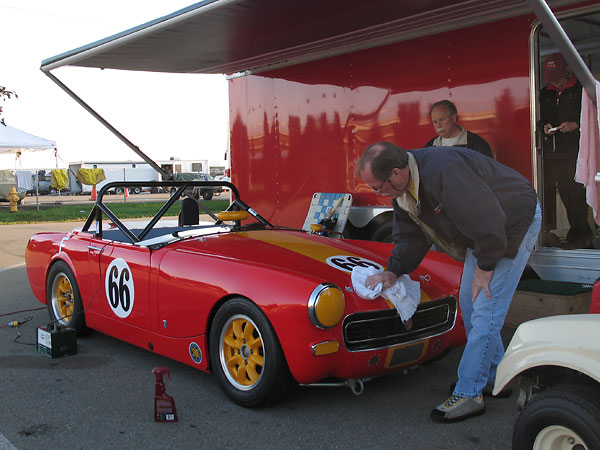
�
One sign of an exquisitely well-prepared race car is that the crew has plenty of time
�
for relaxing activities like polishing the paint and brightwork.
�
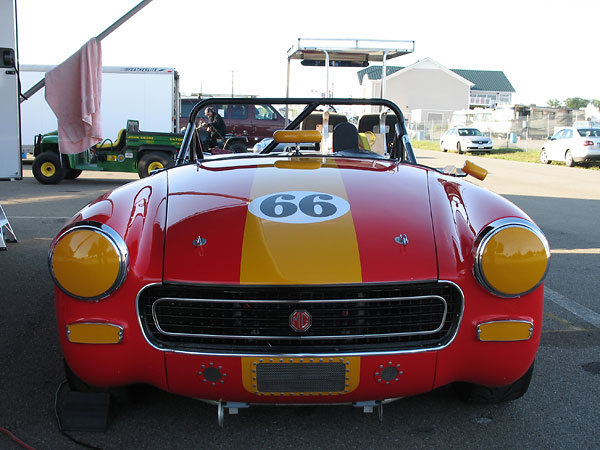
�
Who can resist such a cheeky grin!
�
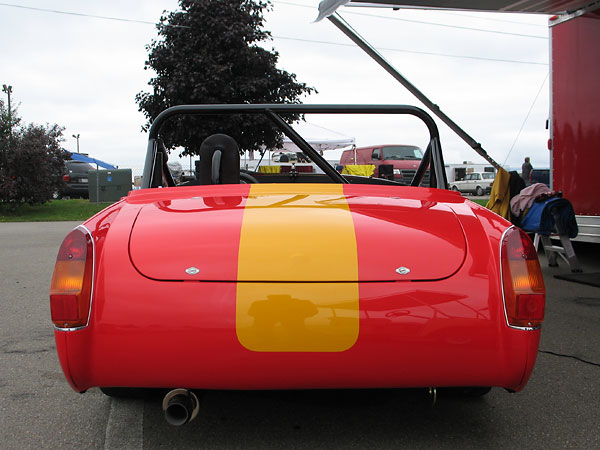
�
Dzus quarter-turn fasteners are both lighter and more secure than the original boot latch.
�
�
All photos shown here are from September 2009 when we viewed the car at The US Vintage Grand �
Prix at Watkins Glen. All photos by Curtis Jacobson and Don Moyer for BritishRaceCar.com, copyright 2010. �
All rights reserved.
�
| If you liked this article, you'll probably also enjoy these: | �|||||
 | �
Harry Gentry '62 MG Midget | �
 | �
Rick Haynes '65 MG Midget | �
 | �
Chuck Pitt '68 Spridget | �
| You're invited to discuss anything you've seen here on The British Racecar Motorsports Forum! | �|||||
�
Notice: all the articles and almost all the photos on BritishRacecar.com are by Curtis Jacobson.
�
(Photos that aren't by Curtis are explicitly credited.) Reproduction without prior written permission is prohibited.
�
Contact us to purchase images or reproduction permission. Higher resolution images are optionally available.
�

 �
�